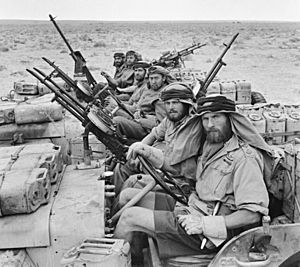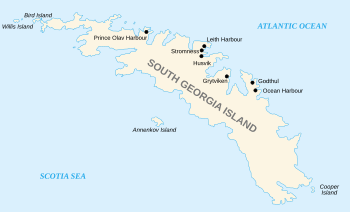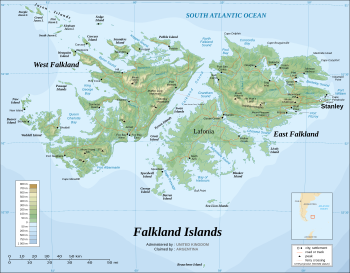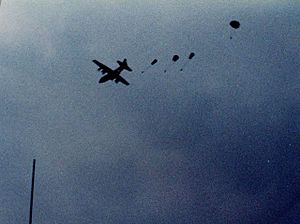History of the Special Air Service facts for kids
The Special Air Service (SAS) is a famous special forces unit of the British Army. Its history began during World War II in North Africa. Since then, the SAS has taken part in many of the United Kingdom's conflicts. They are known for their bravery and secret operations.
Contents
- Second World War
- Malaya: Reforming the SAS
- Oman and Borneo: New Challenges
- Northern Ireland: Covert Operations
- Counter Terrorist Wing: Protecting the UK
- Falklands War: Island Conflict
- Gulf War: Scud Hunters
- Yugoslav Wars: Peacekeeping and War Criminals
- Sierra Leone: Hostage Rescue
- War on Terror: Global Fight
- Libya (2011)
Second World War
The Special Air Service started in July 1941, during World War II. It was the idea of Lieutenant David Stirling. He wanted small teams of parachute soldiers to work behind enemy lines. Their jobs would be to gather information, destroy enemy planes, and attack supply routes.
General Claude Auchinleck liked Stirling's plan. Stirling's unit was called L Detachment Special Air Service Brigade. It had five officers and 60 other soldiers.
After training, L Detachment had its first mission, Operation Squatter. They parachuted behind enemy lines. But bad weather and strong enemy resistance made it a disaster. 22 men were killed or captured.
Given a second chance, L Detachment recruited more men. Their next mission was much better. They were taken by the Long Range Desert Group (LRDG). They attacked three airfields in Libya. They destroyed 60 aircraft without losing any men.
In October 1941, the SAS chose its famous emblem. It was the flaming sword of Excalibur, like King Arthur's sword. Their motto became "." This motto showed their courage and confidence.
1942: Growing Stronger
In 1942, the SAS attacked Buerat, damaging the harbour and fuel tanks. They also raided Benghazi harbour. In July 1942, Stirling led a joint SAS/LRDG patrol. They destroyed 30 aircraft at Fuka and Mersa Matruh airfields.
By September 1942, the unit was renamed 1st SAS Regiment. It included British, French, and Greek squadrons. It also had the Special Boat Service (SBS).

They took part in Operation Agreement and Operation Bigamy. Operation Bigamy was a large raid on Benghazi. But the SAS were discovered and had to pull back. Operation Agreement was a joint mission with the LRDG. They captured an inlet for a sea landing. But the main landing failed, and many were captured.
1943: New Leaders and Missions
In January 1943, David Stirling was captured. He spent the rest of the war as a prisoner. Paddy Mayne took over as commander of 1st SAS. In April 1943, 1st SAS became the Special Raiding Squadron. The SBS became a separate unit.
The Special Raiding Squadron led the invasion of Sicily. They raided the Italian coast. Stirling's older brother, Lieutenant Colonel Bill Stirling, formed 2nd SAS in Algeria.
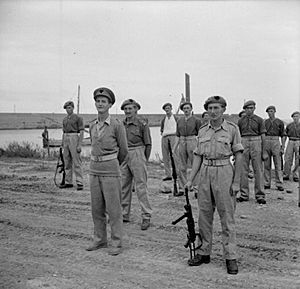
2nd SAS also supported the Sicily landings. Operation Narcissus was a raid on a lighthouse. Operation Chestnut involved parachuting into northern Sicily to disrupt enemy communications.
In mainland Italy, 2nd SAS took part in Operation Begonia. They parachuted in to find escaped prisoners of war. They helped them get to beaches for rescue. Later in the year, 1st and 2nd SAS were sent back to the United Kingdom.
1944: The SAS Brigade
In March 1944, 1st and 2nd SAS Regiments returned to the UK. They joined the new SAS Brigade. This brigade also included French and Belgian SAS units. Their job was to stop German reinforcements. They parachuted behind enemy lines to help the French Resistance.
In support of the Normandy Invasion, 1st SAS took part in Operation Houndsworth and Operation Bulbasket in France. In Operation Bulbasket, 32 men were captured and executed by the Germans. French SAS units were also very active.
In August, 1st SAS was involved in Operation Loyton in the Vosges Mountains. They faced strong German forces and bad weather. 31 men were captured and executed. Also in August, 2nd SAS worked with the French resistance. They caused a lot of damage to the enemy. Near the end of the year, 2nd SAS went to Italy for Operation Tombola. They worked with the Italian resistance until Italy was freed.
1945: End of the War
In March, Brigadier Mike Calvert took command of the SAS Brigade. In April, 3rd and 4th SAS took part in Operation Amherst. They captured key facilities from the Germans.
In Italy, Major Roy Farran and 2nd SAS raided a German headquarters. They killed the corps chief of staff.
By the end of World War II in Europe, the SAS brigade had suffered 330 casualties. But they had killed or wounded 7,733 enemies and captured 23,000. Soon after, the SAS brigade was broken up. The British 1st and 2nd SAS regiments were disbanded on 8 October 1945.
Malaya: Reforming the SAS
After the war, the British government decided a special unit like the SAS was still needed. A new SAS regiment was formed as part of the Territorial Army. It was called 21 SAS Regiment.
In 1950, the SAS formed a squadron for the Korean War. But they were sent to the Malayan Emergency instead. This squadron became B Squadron, Malayan Scouts (SAS). Other squadrons were formed from local volunteers and Rhodesian soldiers.
They learned new techniques like resupply by helicopter. They also started a "Hearts and Minds" campaign. Medical teams visited villages to help people. With the help of Iban trackers, they became experts at jungle survival.
The Malayan Scouts (SAS) grew to over 900 men. Their job was to find and destroy terrorists. They used long patrols, ambushes, and tracking. They even learned "treejumping" – parachuting into the thick jungle canopy.
In February 1951, B Squadron carried out the first parachute drop in Malaya. This was Operation Helsby. The need for a regular army SAS regiment was clear. So, in 1952, the Malayan Scouts (SAS) were renamed 22 SAS Regiment.
Oman and Borneo: New Challenges
In 1958, 22 SAS Regiment sent two squadrons to Oman. In January 1959, A Squadron defeated a large Guerrilla force. This victory was kept secret.
After Oman, 22 SAS Regiment moved to Hereford in the UK in 1960. A third SAS regiment, 23 SAS Regiment, was formed as part of the Territorial Army.
The regiment was then sent to Borneo for the Indonesia–Malaysia confrontation. They patrolled deep into Indonesian territory. They used local tribesmen for information. Soldiers sometimes lived in villages for months to gain trust.

In December 1963, the SAS went on the offensive. They used a "shoot and scoot" tactic to keep their casualties low. They formed "Killer Groups" to cross the border. These groups disrupted the Indonesian Army. The Borneo campaign cost the British 59 killed.
The SAS returned to Oman in 1970. They helped fight the Dhofar Rebellion. They trained local tribesmen called Firquts. This campaign ended after the Battle of Mirbat in 1972. A small SAS force and Firquts defeated 250 enemy fighters.
Northern Ireland: Covert Operations
In 1969, D Squadron, 22 SAS, deployed to Northern Ireland. They returned in 1972 for intelligence gathering. By 1977, two squadrons were operating there. They used secret patrols in unmarked civilian cars.
The SAS's early successes led to fear among Republican groups. On 2 May 1980, Captain Herbert Westmacott was killed in Belfast. He was leading a plain clothes SAS patrol. An IRA unit opened fire, killing him instantly.
The SAS increased its focus on Northern Ireland. A small unit called the Ulster Troop was permanently stationed there. They provided specialist support to the British Army and police. Surveillance became very important.
On 8 May 1987, the SAS carried out Operation Judy. Eight IRA men were killed while trying to attack the Loughgall police station. The SAS had been waiting in ambush.
In the 1990s, the SAS continued to operate in Northern Ireland. They killed 11 IRA men in ambushes.
Counter Terrorist Wing: Protecting the UK
In the early 1970s, the SAS formed its Counter Revolutionary Warfare (CRW) wing. This was to prepare for terrorist attacks like the 1972 Munich massacre. The first 20-man SAS Counter Terrorist (CT) unit was quickly ready. They developed new tools like the "flashbang" or "stun" grenade.
Home Operations
Their first mission in the UK was on 7 January 1975. An Iranian hijacked a plane at Stansted Airport. The hijacker was captured without shots fired. The SAS was also deployed during the Balcombe Street Siege.
Iranian Embassy Siege
The Iranian Embassy Siege began on 30 April 1980. Six terrorists took over the Iranian embassy in London. They took 26 hostages. After six days, they killed a hostage. Prime Minister Margaret Thatcher ordered the SAS to act.
B Squadron, the duty CRW squadron, was called in. The operation was called Operation Nimrod. The SAS stormed the building, rescuing most of the hostages.
Peterhead Prison Riot
On 28 September 1987, prisoners took over D Wing of Peterhead Prison. They took a prison officer hostage. Negotiations failed. The SAS CRW troops arrived by helicopter. They landed on the roof and abseiled into the prison. Armed with pistols, batons, and stun grenades, they quickly ended the riot.
War on Terror in the UK
After the London bombings in 2005, the SAS CRW helped capture suspects. They also provided expert help with explosive entry techniques. Plain clothes SAS teams monitored airports and train stations.
A small part of the CRW was permanently deployed to London. They provide immediate help to the police during terrorist incidents. The police lead in such events, but the military provides support when needed.
Falklands War: Island Conflict
The Falklands War began on 2 April 1982, when Argentina occupied the Falkland Islands. D Squadron of 22 SAS was sent first, followed by G Squadron.
South Georgia: First Liberation
Operation Paraquet was the mission to free South Georgia. In terrible weather, the SAS, SBS, and Royal Marines forced the Argentinian soldiers to surrender. Two helicopters crashed during the SAS landing on the Fortuna Glacier. The SAS unit had to be evacuated.
The next day, a force of SAS, SBS, and Royal Marines reached Grytviken. They forced the Argentinians to surrender.
Main Landings: San Carlos
Before the main landings, G Squadron patrols landed on East Falkland. The main landings were at San Carlos on 21 May. D Squadron carried out a diversionary raid at Goose Green. They used a Stinger missile to shoot down an Argentinian plane.
A G Squadron patrol found an Argentinian helicopter area near Stanley. RAF Harrier jets attacked, destroying several helicopters.
Pebble Island Raid
On the night of 14/15 May, D Squadron SAS raided the Pebble Island airstrip. Twenty men destroyed six planes and a transport aircraft. They used mortars and small arms fire.
Sea King Crash
On 19 May, the SAS suffered its worst loss since World War II. A Westland Sea King helicopter crashed, killing 22 men. Only nine men escaped before it sank. It is thought a bird strike caused the crash.
Operation Mikado
Operation Mikado was a plan to land B Squadron SAS at an Argentinian airbase. The plan was cancelled.
B Squadron later parachuted into the South Atlantic to reinforce D Squadron.
West Falkland and Wireless Ridge
D Squadron SAS deployed to West Falkland to observe Argentinian forces. On 10 June, Captain John Hamilton's patrol was attacked. Hamilton was killed covering his signaller's escape. He was awarded the Military Cross.
The last major action for the SAS was a raid on East Falkland on 14 June. D and G Squadrons carried out a diversionary raid. This helped the Parachute Regiment assault Wireless Ridge. The raid was a success, harassing the Argentinian forces.
Gulf War: Scud Hunters
The Gulf War began after Iraq invaded Kuwait in August 1990. About 300 SAS members were deployed. This was the largest SAS deployment since World War II.
The SAS was tasked with hunting Scud missiles. These missiles were being fired at Israel. This made the SAS's role much more important. They worked behind Iraqi lines, looking for Scud launchers. They used Land Rovers and sometimes attacked with MILAN missiles.
On 22 January, three B Squadron patrols were inserted by helicopter. One patrol, Bravo Two Zero, was found by Iraqi forces. They could not call for help. Three men were killed, and four were captured. Only one man, Chris Ryan, escaped to Syria. He made history with the longest escape by an SAS soldier.
A and D squadron mobile patrols tracked down Scuds. They destroyed them or called in air strikes. They used "mothership" trucks for resupply. This allowed them to stay in Iraq for a long time.
The SAS operated in Iraq for 43 days. They were crucial in stopping the Scuds. General Norman Schwarzkopf thanked them for keeping Israel out of the war. By the end of the war, four SAS men were killed and five captured.
Yugoslav Wars: Peacekeeping and War Criminals
Bosnian War
In 1994–95, SAS members were deployed to Bosnia and Herzegovina. They wore UN uniforms to gather information in "safe areas." They were also equipped to guide NATO air strikes.
During the Siege of Goražde, an SAS operator was killed. Another SAS team rescued a British pilot whose plane was shot down. This team also called in air strikes.
An SAS team was sent to Srebrenica. They tried to call in air strikes as Serbian forces attacked. But they were ordered to withdraw. The city fell, leading to a terrible massacre.
After the war, the SAS hunted war criminals. They captured several wanted individuals.
Kosovo War
In 1999, D Squadron deployed to Kosovo. They guided NATO air strikes and scouted routes for a ground force. G Squadron also helped secure bridgeheads for NATO.
After the war, the SAS continued to operate in Kosovo. In 2001, G Squadron spearheaded an operation to arrest 22 Albanians suspected of a bus attack.
Sierra Leone: Hostage Rescue
The SAS and SBS were deployed to Sierra Leone in 2000. They supported Operation Palliser. They gathered information on rebel forces.
Operation Barras
In 2000, D Squadron 22 SAS, SBS, and Parachute Regiment soldiers carried out Operation Barras. Their mission was to rescue five British soldiers and a Sierra Leone officer. These hostages were held by the West Side Boys militia.
The rescue team attacked the militia positions from helicopters. After a heavy fight, the hostages were freed. One SAS soldier was killed during the operation.
War on Terror: Global Fight
After the September 11 attacks in 2001, the SAS joined the "War on Terror."
War in Afghanistan (2001–2021)
Operations in Afghanistan began in October 2001. The SAS escorted Prime Minister Tony Blair in 2002. They also conducted raids, storming villages and capturing suspects.
SAS reservists helped set up communication networks. They also acted as links between different groups. In 2008, four SAS reservists were killed when their vehicle hit a mine.
From 2009, two SAS squadrons focused on Afghanistan. They targeted Taliban leaders. In 2010, SAS teams took part in Operation Moshtarak. They conducted "find, fix, strike" raids, killing many Taliban leaders.
In 2011, a British officer said the SAS was "taking out 130–140 mid-level Taliban commanders every month." In 2012, the SAS rescued a British aid worker and three other hostages. They killed eleven gunmen in the rescue.
After NATO ended combat operations in 2014, about 100 British Special Forces, including SAS, remained. They continued to hunt Taliban and al-Qaeda leaders.
Iraq War: Task Force Black
The SAS took part in the 2003 invasion of Iraq. They operated in Western and Southern Iraq. They also escorted MI6 officers into Baghdad.
The SAS became part of Task Force Black. They fought against the Iraqi Insurgency. In 2004, A Squadron carried out 175 combat missions in six months.
In 2006, the SAS helped release peace activists held hostage in Iraq. In April 2006, an SAS operation led to the death of AQI leader Abu Musab al-Zarqawi. In March 2007, G Squadron captured a senior Shia militant, Qais Khazali. This raid provided valuable information.
The SAS used new armoured vehicles like the Bushmaster. The UKSF deployment to Iraq ended in May 2009. Six SAS soldiers were killed and 30 injured during the war.
Somalia and Yemen
In 2009, SAS members were deployed to Djibouti. They carried out operations against Islamist terrorists in Yemen and Somalia. They trained local forces and helped capture or kill terrorist leaders.
International Military Intervention Against ISIL
Since 2014, the SAS has been part of Operation Shader against ISIL. They gather intelligence and help refugees. They also help Kurdish forces in Iraq and operate in Syria.
In 2015, the SAS confirmed the presence of a senior ISIL leader, Abu Sayyaf, who was then killed by US Special Forces. In 2016, the SAS was given a list of 200 British jihadists to kill or capture. SAS snipers targeted ISIL insurgents.
In March 2018, SAS Sergeant Matt Tonroe was killed in Syria during an anti-ISIL mission.
Libya (2014–present)
Since 2016, the SAS has been deployed to Libya. They escort MI6 agents to meet Libyan officials. They help organize weapons and training for forces fighting ISIL.
Libya (2011)
In March 2011, a joint SAS-MI6 team was captured by Libyan rebels during the 2011 Libyan civil war. They were later released. A troop of 20 SAS soldiers deployed to Eastern Libya. They trained and coordinated opposition groups. They also directed NATO airstrikes.


